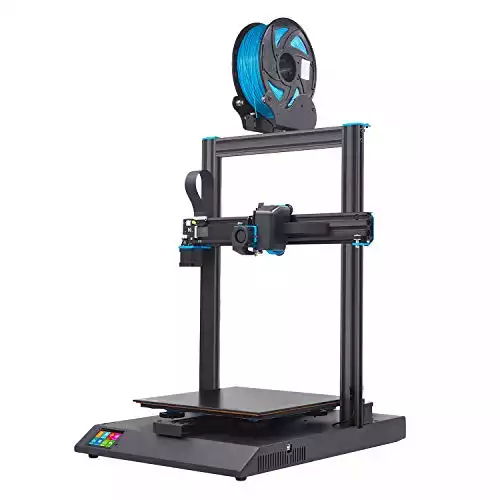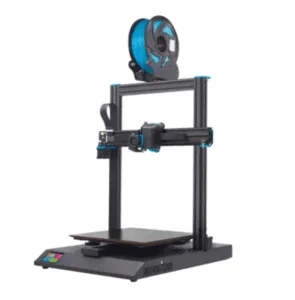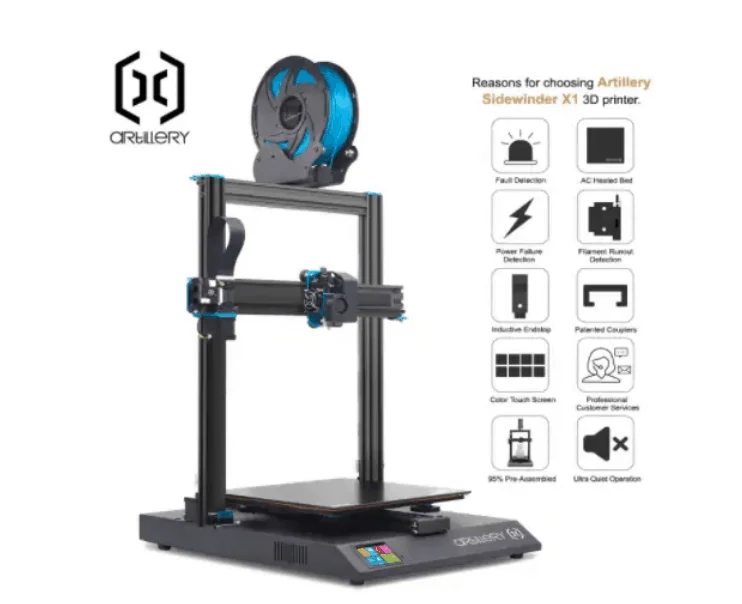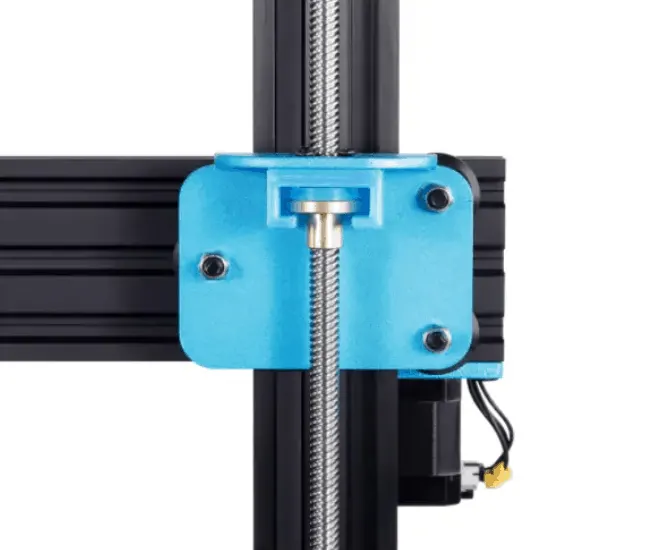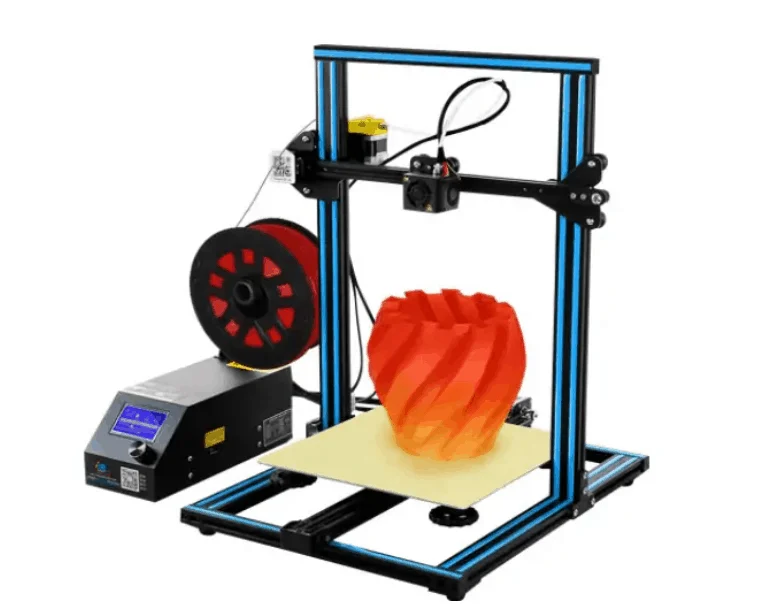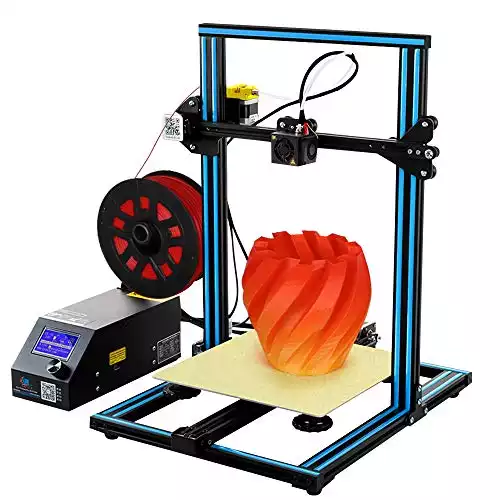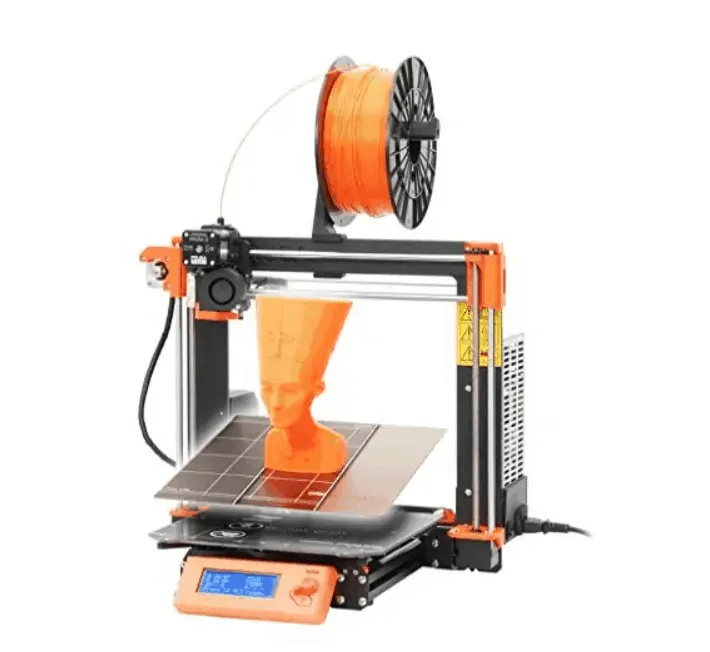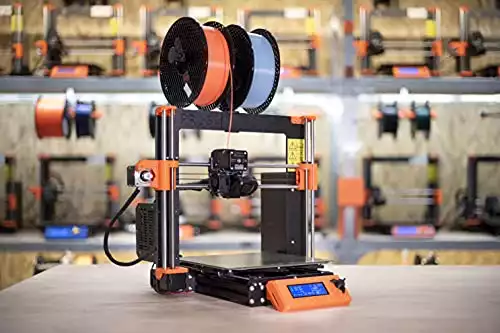- Flashforge Creator 3 Review [2022]: Our Honest Opinion - April 5, 2022
- Anycubic Photon Review [2022]: Will This Work for You? - April 5, 2022
- X-Carve Review [2020]: Is This CNC Machine Right For You? - April 4, 2022
Artillery is pretty green. They’ve only been around since October of 2018, but they got off on the right foot, releasing a 3D printer that goes toe to toe with plenty of other quality, budget 3D printers.
Their first printer, the Artillery Sidewinder X1 rings up at less than $500, which is a steal in this sector. But don’t let that fool you. It still has an impressive list of features.
Artillery also plowed through plenty of negative user feedback to produce subsequent iterations that work more smoothly. The manufacturer always seems to have an ear to the ground with quick fixes for an already rock-solid printer.
They’re currently on their fourth generation Sidewinder X1, and it definitely lives up to my expectations.
Artillery Sidewinder X1 is a all-in-one cartesian 3D printer with ultra quiet stepper drivers, direct drive extruder, dual Z axis, AC heated bed, TFT touch screen.
Table of Contents
Specifications
It’s not always all about the specs, but it’s a quick peek at the size, design, and features.
- Version: Artillery Sidewinder S1 V4
- Year: 2019
- Assembly: Pre-assembled
- Technology: FDM
- Mechanical arrangement: Cartesian-XY-Head
- Build volume: 11.8 x 11.8 x 15.75 inches (300 x 300 x 400 mm)
- Outer dimensions: 550 x 405 x 640 mm
- Weight: 16.5 kg
- Layer height: 0.05 mm
- Nozzle type: Volcano
- Nozzle size: 0.4 mm
- Extruder type: Direct drive
- Maximum extruder temperature: 240°C
- Maximum heated bed temperature: 80°C
- Bed leveling: Manual
- Print bed: Rapid-heating AC bed
- Print chamber: Open
- Frame: Aluminum
- Display: Touchscreen
- Connectivity: SD, USB cable
- Print recover: Yes
- Built-in camera: No
- Filament sensor: Yes
- Filament diameter: 1.75 mm
- Materials: ABS, HIPS, PLA, flexible PLA, PVA, TPU
- Third-party filaments: Yes
- Operating systems: Windows, Mac, Linux
- Recommended slicer: Cura, Simplyfy3D, Slic3r
Setup and Settings
The Sidewinder X1 comes pre-assembled in an organized box, and the setup is seamless. The only things you have to do are attach the gantry to the base with screws, plug in the ribbon cables, and bolt the filament holder to the top.
Unfortunately, there are no bed leveling sensors, so it’s a manual process. However, it does come with an assisted leveling system to make the task less complicated.
Artillery doesn’t have a proprietary slicer, which is nice for those who like open-source slicers like Cura. Cura offers a full range of controls that allow you to experiment and fine-tune your settings.
The default Artillery settings will work fine for beginners, though. The only thing you may have to do is reduce the print speed for better quality. It’s tempting to reduce printing time, but large prints will wobble much more at high speeds and the printer performs much better at low speeds.
Technology
A 3D printer is really only as good as the technology it’s equipped with. After all, you could have a fantastic design and huge print volume, but if it’s built using low-quality materials, you’ll never be able to experience its true potential, or yours.
Artillery is based in Shenzhen and I discovered after some research that they also market their devices under the brand name Evnovo. The Sidewinder X1 is their first 3D printer, but they’re currently offering the fourth version, with many improvements over the first.
If features top of the line capabilities like a sturdy chassis, large print bed with fast heating, and a direct drive extruder system. These have all been present since the beginning, but the latest version is just so much better, so let’s dig into more detail.
Artillery Sidewinder X1 is a all-in-one cartesian 3D printer with ultra quiet stepper drivers, direct drive extruder, dual Z axis, AC heated bed, TFT touch screen.
Design
While the Artillery Sidewinder X1 takes a lot of inspiration from the Creality CR-10-style, it’s so much sleeker in my opinion. Plus, the technology is more than a mere clone as well.
The mainboard, touchscreen, and power supply are all stored on the base unit so it looks more uniform, it’s much more convenient, and it adds to the design rather than detracting from it.
It has a sleek and professional appearance which is a huge step up from similarly priced alternatives.
The Sidewinder X1 is also much different from competitors in terms of the use of ribbon cables. From a design perspective, this 3D printer moves to the top of the list. Other budget desktop printers have huge, mangled messes of cabling, but this one offers neatly arranged ribbon cables instead.
In previous iterations, these ribbon cables were nothing but complicated. They broke and they wore out thanks to the printer’s rapid motion. While I have had limited contact with the machine compared to those who use their daily, the ribbon cables on this iteration seem to handle the stress much better.
Thankfully, the company listens to user feedback and fixes issues. They also threw in an extra set of ribbon cables, just in case. There are also some interesting workarounds on Thingiverse if you’re interested in prolonging the life of your cables.
Framework
While it’s fairly common to see sturdy Y-axis rails, even on budget printers these days, a hefty X-axis rail is harder to come by. But, as you may have already guessed, the X1 has it. A 20 x 60 mm extrusion lends support to the direct drive setup.
A dual lead screw design operates the Z-axis, equipped with anti-backlash nuts to keep everything synchronized. There’s also a connector belt with a pulley to prevent desyncing over time.
It’s not the most elegant solution (dual end stops would be better), but it functions fine for a printer at this price point, and you really can’t expect much more.
There are 20 x 40 mmm extrusions on the base unit, held in place by four screws. This solid scaffold prevents wobbling of the Z-axis, which is especially handy when you have such a tall build space.
It could be improved with an angle connector to prevent even more wobbling because the X1 does tend to wobble toward the top. Aside from that, this printer has a sleek and sturdy appearance.
Print Bed
At the heart of every 3D printer is a bed, and the Sidewinder X1’s heart beats for you. It offers a huge 300 x 300 x 400 mm space with a porous glass surface coated in ceramic.
The volume of the X1 is definitely above average, but it really shines when you evaluate its ability to go from zero to printing in mere seconds. 45 to be exact. The print bed heats from room temperature to maximum temperature that fast.
Artillery equipped the bed to heat so quickly by mounting the heater on the underside of the glass with no metal plate in between the two. It’s AC heated rather than DC heated, so it’s heated with 220/110V rather than 24V. It’s one of the only printers to do it this way.
Of course, there’s always a downside. In this case, you run the risk of electric shock, especially with connectors exposed to motion a lot of the time. However, all of the wires are insulated, so that alleviates the problem somewhat.
While the spec sheet indicates a max heated bed temp of 80°C, it is actually capable of 120°C, which comes in handy when printing with temperature-sensitive materials. Unfortunately, the bed doesn’t do a great job of temperature dispersion, so it’s cooler along the outer edges, causing adhesion problems with larger objects.
The ceramic glass plate does offer great bed adhesion though because it expands with heat and shrinks again as it cools down. The final prints literally pop right off. One other drawback is that you can’t remove the bed. With such a large print volume, it would be nice to remove the bed for better access, but as the prints pop off so easily, it’s not really necessary.
Extruder
The extruder is where the real magic happens. The Sidewinder X1 is equipped with a direct drive Titan Aero extruder and a Volcano hot end. Direct drive extruders are rare at this price point, but Artillery included it because, well, it’s better.
Just like the print bed, the hot end heats up to its max temp rather quickly. And once again, despite an advertised max temp of 240°C, it can actually reach 270°C. It’s safer and more effective at around 240 or 250°C just to ensure the cold end isn’t damaged.
The Volcano hot end has an elongated melt zone, giving you high flow rates and enabling the use of nozzles with larger diameters like 0.8 or 1mm.
It has two fans. The one that cools the extruder does a fine job but the one that cools the prints could be better. You’re better off reserving your first print job for a fan duct alternative to improve this piece. Not only is it one of the smallest pieces of the printer, but it’s also the loudest.
UI and Connectivity
The 3.5-inch color touchscreen is a lot more than you’ll get with many other comparable 3D printers. It’s easy to use and features different colors for each submenu. Every feature is accessible from this menu, unlike other firmware that offers only a subset of operations on the touchscreen.
The Sidewinder X1 offers support for both USB and micro SD. The USB connection makes it easy to plug your computer directly into the printer while the micro SD is ideal for those who don’t work in the same room as they print.
Performance
Overall, the performance of the Sidewinder X1 is excellent. However, as i mentioned before, you may want to print an alternative fan for cooling your print jobs in addition to a filament spool holder.
Changing the filaments is less than ideal and could be made easier. The stock filament holder has two parts bolted to the frame. If you only use one brand of filament, you can adjust these screws once and be done.
However, if you swap brands or switch back and forth frequently, you’ll constantly be adjusting the holder. It’s also not the easiest part of the printer to access if it’s sitting on a shelf or against the wall. Using the ever-so-common PLA filament really didn’t put the printer through its paces, so I increased the difficulty to really test it out. PLA is always a solid choice. Everything turns out well, even at a higher speed.
However, it also handles ABS well without any warping, despite the print bed’s inconsistent heat dissipation. It helps to use a lot of glue beforehand, just to make sure. It’s always surprising to find an open printer that prints well with ABS, and the Sidewinder X1 does.
You’ll run into quite a few problems if you try to print with PETG, which was surprising, given its ability to handle inconsistent temperatures well. Unfortunately, PETG resulted in some blobs and failing in the first layer. This problem isn’t specific to the Sidewinder X1 and is actually common in Volcano hot ends. You can manage it by adjusting the retraction settings and enabling the Cura coasting feature, but you may still encounter problems.
The direct drive extruder handles flexible filaments with no feeding problems. It may string a bit occasionally, but that’s what I expected. Overall, the Sidewinder X1 can print with plenty of different materials, but the everyday use of PLA is where it really shines.
Usability
Like I said before, the menu is colorful and easy to use. You touch it and it responds accordingly. Built-in features like resume print and the filament runout sensor work great. As a bonus, the heated bed stays heated while you add more filament.
You can even come back hours later to add the material and restart the print without worrying about it detaching. Nifty, right?
And while you can’t bump the bed when switching out filament, you can move axes via the touch screen before resuming. Obviously, in the case of a power outage, the bed does not stay heated, but it will still resume the print with no problem once the power comes back on.
The Sidewinder X1, with the exception of the cooling fan, is rather quiet in comparison to other alternatives. It operates at about 45 dB.
Pros:
- Sleek design
- Fast heating
- Silent operation
- Surprising performance
- Affordable
Cons:
- Less than ideal filament holder
- Uneven heat dissipation
Alternatives
At this price point, you’ll find quite a few comparable alternatives. Here are some of your options.
Creality CR-10
The Sidewinder X1 takes its design cues from the Creality CR-10, so it’s pretty comparable in terms of not only design but price and functionality. The print volume is identical but Creality offers other models with even bigger print volumes whereas Artillery doesn’t.
The assembly is easy and the control box is intuitive, but the print bed is removable, which is an improvement over the Sidewinder. Downsides are that the print bed takes a long time to heat up, print setup can be tedious, and the filament holder is prone to tangling.
The CR-10S comes with a convenient monitor that will detect when the printer has run out of filament, automatically pausing the print, and will alert the user to restock the Filament before continuing. Say goodbye to wasted Filament and time.
Prusa i3
The Prusa i3 is another open-source 3D printer offering an affordable price and plenty of features. The print volume is double that of the Sidewinder and it has a removable bed, but performance is sometimes less than reliable.
It operates best with the Slic3r software, although you can use Cura if you prefer. It has an auto-leveling feature and features a very sturdy frame, offering support for its large build volume. However, it’s about double the price of the Sidewinder.
Basic features magnetic PEI Spring steel sheet EINSY RAMBo Base plate Silent Trinamic drivers with 256 microstepping Maximum travel speed: 7.874 in per second. The Original Prusa i3 MK3S+ is the latest version of their award-winning 3D printers.
FAQs
There are plenty of great options for beginners. The Anycubic Photon is great for printing with resin, the Monoprice Select Mini V2 is the best value for the price, and the Flashforge Adventurer 3 is the easiest to use.
It still all depends on which features you want, how much you want to spend, and how much room you need to grow your skills.
3D printers vary in price quite a bit. Some of the more affordable solutions, like the Artillery Sidewinder X1, are less than $500. However, there are plenty of upgrades that add to the cost, not to mention higher quality printers that cost in excess of $1000. Some even cost multiple thousands.
How much you spend depends on the features you need. Beginners and recreational users will likely not spend as much money while serious hobbyists or small businesses might opt for something more feature-rich and more costly.
3D printers are good for all kinds of projects. They’re great for small businesses to create prototypes or for large businesses to manufacture objects. They’re also great learning tools for small children as well as students of all ages.
Universities everywhere invest in 3D printers so students can work with the latest technology, but even if you’re just a hobbyist at home, you may enjoy a 3D printer for small projects and replicas.
Final Thoughts
The Artillery Sidewinder X1 features innovative technology like the AC heated bed and direct drive extruder. It also has a rather large print volume and decent performance. However, you’ll probably have to replace some of the less-than-perfect parts right away.
It also tends to wobble at the top of the Z-axis, but it’s an affordable printer that’s incredibly user friendly and capable of quality prints that may surprise you.
The list of features is impressive, the technology is superb, the price is right, and it beats out most of the competition in terms of ease of use and fun.
Artillery Sidewinder X1 is a all-in-one cartesian 3D printer with ultra quiet stepper drivers, direct drive extruder, dual Z axis, AC heated bed, TFT touch screen.



